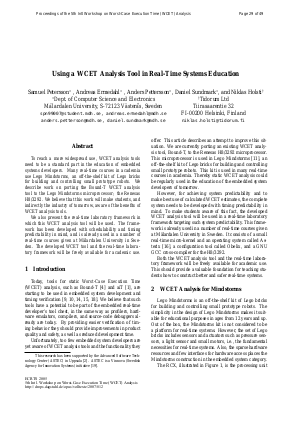Using a WCET Analysis Tool in Real-Time Systems Education
Authors Samuel Petersson, Andreas Ermedahl, Anders Pettersson, Daniel Sundmark, Niklas Holsti
-
Part of:
Volume:
5th International Workshop on Worst-Case Execution Time Analysis (WCET'05) (WCET 2005)
Part of: Series: Open Access Series in Informatics (OASIcs)
Part of: Conference: Workshop on Worst-Case Execution Time Analysis (WCET) - License:
 Creative Commons Attribution-NonCommercial-NoDerivs 3.0 Unported license
Creative Commons Attribution-NonCommercial-NoDerivs 3.0 Unported license
- Publication Date: 2007-03-29
File

PDF
OASIcs.WCET.2005.812.pdf
- Filesize: 307 kB
- 4 pages
Document Identifiers
Metrics
- Access Statistics
-
Total Accesses (updated on a weekly basis)
0Document
0Metadata
Abstract
To reach a more widespread use, WCET analysis tools need to be a standard part in the education of embedded systems developers. Many real-time courses in academia use Lego Mindstorms, an off-the-shelf kit of Lego bricks for building and controlling small prototype robots. We describe work on porting the Bound-T WCET analysis tool to the Lego Mindstorms microprocessor; the Renesas H8/3292. We believe that this work will make students, and indirectly the industry of tomorrow, aware of the benefits of WCET analysis tools. We also present the real-time laboratory framework in which this WCET analysis tool will be used. The framework has been developed with schedulability and timing predictability in mind, and is already used in a number of real-time courses given at M¨alardalen University in Sweden. The developed WCET tool and the real-time laboratory framework will be freely available for academic use.
Cite As Get BibTex
Samuel Petersson, Andreas Ermedahl, Anders Pettersson, Daniel Sundmark, and Niklas Holsti. Using a WCET Analysis Tool in Real-Time Systems Education. In 5th International Workshop on Worst-Case Execution Time Analysis (WCET'05). Open Access Series in Informatics (OASIcs), Volume 1, pp. 29-32, Schloss Dagstuhl – Leibniz-Zentrum für Informatik (2007)
https://doi.org/10.4230/OASIcs.WCET.2005.812
BibTex
@InProceedings{petersson_et_al:OASIcs.WCET.2005.812,
author = {Petersson, Samuel and Ermedahl, Andreas and Pettersson, Anders and Sundmark, Daniel and Holsti, Niklas},
title = {{Using a WCET Analysis Tool in Real-Time Systems Education}},
booktitle = {5th International Workshop on Worst-Case Execution Time Analysis (WCET'05)},
pages = {29--32},
series = {Open Access Series in Informatics (OASIcs)},
ISBN = {978-3-939897-24-8},
ISSN = {2190-6807},
year = {2007},
volume = {1},
editor = {Wilhelm, Reinhard},
publisher = {Schloss Dagstuhl -- Leibniz-Zentrum f{\"u}r Informatik},
address = {Dagstuhl, Germany},
URL = {https://drops.dagstuhl.de/entities/document/10.4230/OASIcs.WCET.2005.812},
URN = {urn:nbn:de:0030-drops-8126},
doi = {10.4230/OASIcs.WCET.2005.812},
annote = {Keywords: }
}
